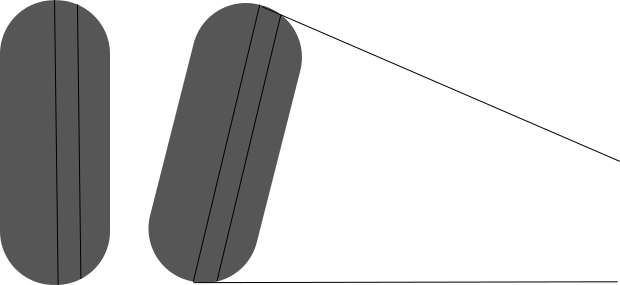Why we lean#
Mon May 27 17:47:26 2024
I think I have mostly figured out, in my own head, why lean and why counter-lean and when. This may be one of those subjects where once you understand it you lose the abilty to explain it but here goes anyway.
You can turn a bike by steering it (turning the front wheel by moving the bars), or by leaning it, or by a combination of the two.
Steering is like in a car: the wheel is pointing at an angle to the direction of travel. The tyre sticks to the road a bit instead of sliding smoothly over it, so the wheel is exerting a force on the rest of the vehicle. This force is acting partly against the direction of travel (providing a "drag" force) and partly at right-angles to the direction of travel (providing a "slip" force). Per Newton, the sideways slip force changes the vehicle's direction of travel to make it go round the corner. On a bike, trying to turn using steering alone will result in falling over. Suppose you're turning left, the bottom of the wheel is being going left slightly, but the bike has mass - and therefore inertia - so this will cause it to rotate rightwards. Once the centre of gravity is no longer over the tyre contact patch, it will topple. The faster you're moving, or the sharper you turn, the greater the sideways force.
Leaning is not like in a car. The diameter of your tyre is largest measured around the centre of the tread and gets smaller as you go off-centre - so if you tilt the tyre then you're rolling on a section of a cone, not a cylinder. That will naturally go round in circles. Here's the thing, though: the radius of the turn depends only on geometry. The shape of the tyre and the angle of lean say how sharp the turn is going to be; the speed you're going at has (approximately) no bearing on that.
So we're rolling a cone and it's turning. Per logic and Newton's first law of motion, we know that to be turning it must have a force acting on it, otherwise it would be going in a straight line. Wikipedia says that a centripetal force has an acceleration of v squared/radius.
So there's a sideways force pushing leftward on the bottom of the wheel, and this is going to tend to rotate the bike rightward. But, the motorbike is already leant over to the left, so there's a competing force from gravity which is going to try to rotate it leftwards. Which one wins?
(This is the bit I haven't figured out: if we're looking at rotation then we should be comparing moments not just forces, but about what point do we measure the moment? The "hinge" is at the ground, but that means the centripetal force would have zero moment; the other obvious point would be the CoG. but that means the gravitational force (which acts at CoG) has zero moment. Anywhere else we can pick seems kind of arbitrary. Anyway, we can handwave the next part ...)
The gravitational force is greater when you're leaning further, and the camber force is greater when you're leaning further (sharper turn) or going faster. We assume you don't go so fast that the tyre loses grip. So there should be some speed for a given turning radius where the two balance. If you want to go around the corner at some other speed, either you can change the sideways force by adding/removing slip (turning the bars) or you can change the turning effect from gravity by shifting your bodyweight to move the overall centre of gravity nearer or further from vertical.
 Thus: WSBK riders get their knees and their elbows down, but
Motogymkhana riders shove their Harleys sideways and stay upright. And
Fortnine is a clickbait merchant. Ryan YOU'RE DOING IT WRONG, for
any value of "it" equal to "explaining things".
Thus: WSBK riders get their knees and their elbows down, but
Motogymkhana riders shove their Harleys sideways and stay upright. And
Fortnine is a clickbait merchant. Ryan YOU'RE DOING IT WRONG, for
any value of "it" equal to "explaining things".
It does feel kind of magical in an "anthropic principle" way that the sideways force we need to go around a corner can be provided by leaning the bike onto the rounded part of the tyre - and that changing the bike's CoG by leaning it is also providing the balancing force that stops the cornering from throwing us off to the outside. God is ~~an astronaut~~ ~~a DJ~~ ~~a cyclist~~.